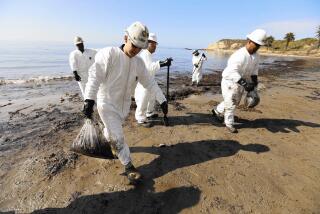Report rebuts a concern about Keystone XL tar-sands oil
- Share via
WASHINGTON — The type of crude oil that would be pumped through the Keystone XL pipeline is no more likely to corrode pipelines or heighten the chance of leaks than other kinds of petroleum, according to a study by the National Research Council, an arm of the National Academy of Sciences and the National Academy of Engineering.
The finding rebuts one concern raised by opponents of the 1,700-mile Canada-to-Texas pipeline. They have long argued that pipelines are more prone to corrosion and leaks if they carry diluted bitumen, the tar-like substance that would be extracted in Alberta mostly by strip mining, mixed with chemicals and pumped at high pressure to refineries.
The National Research Council study did “not find any causes of pipeline failure unique to the transportation of diluted bitumen.” The study was done at the behest of the Transportation Department.
Keystone XL’s critics have contended that pipelines carrying diluted bitumen are more susceptible to leaks because they operate at a higher temperature, increasing the risk of a rupture from external corrosion. But the study found that diluted bitumen “is moved through pipelines in a manner similar to other crude oils with respect to the flow rate, pressure and operating temperature.”
The study also said that diluted bitumen did not contain higher concentrations of substances like water and sediment that could increase the chances of internal corrosion.
Keystone XL’s developer, TransCanada, welcomed the study’s results.
“The public has been bombarded with misinformation about the oil that will go through Keystone XL,” said Vern Meier, vice president of pipeline safety and compliance at TransCanada. “Oil is oil, and the pipelines we build will safely move different blends as the industry has been doing for decades.”
Keystone XL’s critics highlighted what they considered limitations of the study. The National Research Council expert committee did not conduct its own testing of pipelines, for example. Instead, it relied on interviews with industry experts, academics and environmentalists, a review of other studies and fact-finding trips to Alberta.
The study examined Canadian and American government accident reports for pipeline leaks, but the information in them was “insufficient to draw definitive conclusions,” the study found. The government databases lacked enough specificity about pipeline accidents to determine whether transporting diluted bitumen played a role in leaks, the report said.
The report did not address whether spills of diluted bitumen are harder to clean up than spills of conventional crude oil. If the Keystone XL pipeline gets the federal permit it needs for construction, it will carry up to 800,000 barrels of oil a day across land above the Ogallala aquifer, the main source of drinking water for much of the Great Plains.
Cleanup continues of diluted bitumen that spilled three years ago into Michigan’s Kalamazoo River. In another spill in late March, a pipeline ruptured in Mayflower, Ark., gushing 200,000 gallons through a residential neighborhood and into a nearby lake. So far, somewhat more than half the oil spilled there has been recovered.
The Michigan and Arkansas accidents show “that this material is very difficult to remove from water bodies and raise questions about its short- and long-term effects on the health of the people exposed to it after a pipeline failure,” said Carl Weimer, executive director of the Pipeline Safety Trust, a watchdog group based in Bellingham, Wash.
More to Read
Sign up for Essential California
The most important California stories and recommendations in your inbox every morning.
You may occasionally receive promotional content from the Los Angeles Times.













